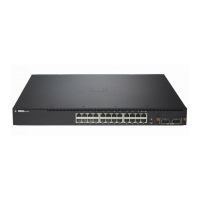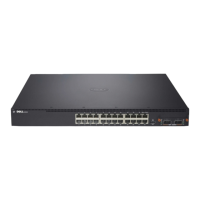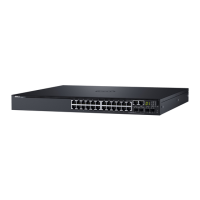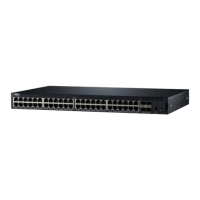566 Configuring VLANs
Trunk ports can receive tagged and untagged traffic. Untagged traffic is
tagged internally with the native VLAN. Native VLAN traffic received
untagged is transmitted untagged on a trunk port.
By default, trunk ports are members of all existing VLANs and will
automatically participate in any newly created VLANs. The administrator can
restrict the VLAN membership of a trunk port. VLAN membership for tagged
frames received on a trunk port is configured separately from the membership
of the native VLAN. To configure a trunk port to accept frames only for a
single VLAN, both the native VLAN and the tagged VLAN membership
settings must be configured.
Access ports accept untagged traffic and traffic tagged with the access port
PVID. Untagged ingress traffic is considered to belong to the VLAN
identified by the PVID.
GVRP
The GARP VLAN Registration Protocol (GVRP) helps to dynamically
manage VLAN memberships on trunk ports. When GARP is enabled,
switches can dynamically register (and de-register) VLAN membership
information with other switches attached to the same segment.
Information about the active VLANs is propagated across all networking
switches in the bridged LAN that support GVRP. You can configure ports to
forbid dynamic VLAN assignment through GVRP.
The operation of GVRP relies upon the services provided by the Generic
Attribute Registration Protocol (GARP). GVRP can create up to 1024 VLANs.
For information about GARP timers, see "What Are GARP and GMRP?" on
page 709.
Double-VLAN Tagging
For trunk ports, which are ports that connect one switch to another switch,
the PowerConnect 7000 Series switches support double-VLAN tagging. This
feature allows service providers to create Virtual Metropolitan Area Networks
(VMANs). With double-VLAN tagging, service providers can pass VLAN
traffic from one customer domain to another through a metro core in a
simple and cost-effective manner. By using an additional tag on the traffic,
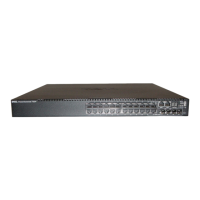
